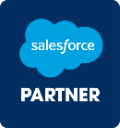- Solutions
-
Products
-
Resources
Sales Automation: What It Is, How It Works, and What to Automate First by Kristi Campbell View all Blog Posts >Get the App, Get the Sidebar, & Get Your Trial Going HereUnleash limitless growth opportunities by partnering with Cirrus Insight.
- Pricing
Filter By:
- All topics
- Sales Intelligence
- Salesforce
- Sales Productivity
- Sales Strategy
- Sales Prospecting
- Book More Meetings
- Sales Activity Data
- Company News
- Sales Leadership
- Sales Metrics
- Team Scheduling
- Prospect Smarter
- AI
- Serious Insights
- Comparison
- Conversation Intelligence
- Sync To Your CRM
- Email Blast
- Email Campaigns
8 Best Sales Enablement Tools of 2025
With so many sales enablement tools out there, it might be hard to find the best one suited for your company. You might have a few questions.
For example, should you use sales enablement software for each part of your business?
One for content marketing, another to manage your sales productivity, and then another for customer relationship management…
We can all agree that eventually, the pricing of 5 + different tools can all add up.
This article will help you find the best enablement tools on the market, and we will also break it up into categories to make it easier to find what you're looking for, along with pricing, reviews, pros, and cons.
How to choose the right sales enablement tools
Yes, sales enablement tools are important, and some of them are awesome, but keep it simple. It's very easy to find yourself buying a CRM, a list enrichment tool, and a tool for outreach.
Before you know it, you can have 6 or even a dozen tools that your team doesn't actually use that much.
The 80/20 principle always applies, and in this case, there is no exception.
Just bear something in mind: Your best sales enablement tool may very well be a Google sheet that keeps track of folks in your pipeline, opportunities you have, and people to reach out to.
And in all honesty, that's how SalesBread was ran for the first 6 years.
That's how some companies grow their business: simply track everything on a spreadsheet and do a lot of things manually.
Is it the most streamlined? No, it isn't. But it worked for the time being.
Eventually, Salesbread did end up upgrading, but they used the spreadsheet every day instead of a sales enablement tool that might have rarely been used. Adding no value to their business.
And I promise you, if you rush and get 3 or 4 different tools in one quarter, you're going to find yourself with sales enablement bloat. You will be in the same situation you're in right now, which is a lack of clarity around your sales efforts and activities.
You might be reading this, and the best tool for you right now is a spreadsheet. And if that's the case, embrace it because the best tool is one you use every day.
Sales appointment and scheduling tools
1. YouCanBookMe

YouCanBookMe is an online sales scheduling tool designed for small businesses. It helps cut down on admin work, attract more clients, and accelerate your sales pipeline. Sales teams who have adopted YCBM have experienced a 25% increase in leads.
Extensive customization options let you enjoy the ease of online scheduling while maintaining a consistent brand experience.
Features
- Customizable Scheduling – Adjust booking pages to match your brand look and feel.
- Calendar Integration – Syncs with Google and Microsoft calendars to avoid double-booking.
- Automated Notifications – Sends email and SMS reminders so clients don’t miss appointments.
- Time Zone Detection – Automatically detects time zones to make scheduling with global clients easier.
- Buffer Times & Availability Settings – Add breaks between meetings and set custom working hours.
- Team Scheduling – Let clients book with specific team members or auto-assign based on availability.
- Payment Integration – Accept payments at the time of booking through Stripe.
- Automated Follow-Up Emails – Automatically send emails after meetings to thank clients or summarize the next steps.
Pros
- Saves time by automating scheduling and follow-ups.
- Easy to use for both sales reps and clients.
- Strong customization keeps the booking experience on-brand.
- Good fit for small businesses and teams that need a simple scheduling tool.
- Free 14-day trial
- Really affordable
Cons
- Advanced features like payments or SMS reminders may require a paid plan
- Best for small to mid-sized teams might not be the best tool for enterprise companies
Pricing
YouCanBookMe is an affordable sales enablement tool. There are 4 options to choose from, from the free version to the Teams option.
Pricing starts at $7.20 per month and works its way up to $14.40 per member per month.
Review
According to G2, YouCanBookMe has a 4.7-star rating out of 5.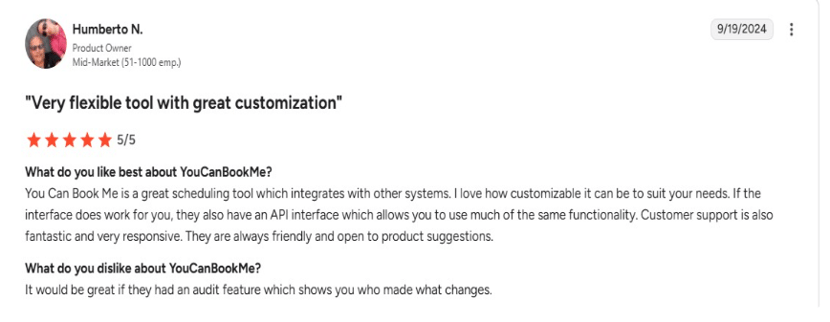
2. Calendly
Calendly is used to make scheduling meetings easier for both internal teams and clients. Instead of going back and forth over email, people can see when team member's are available and book a time that works for them.
Calendly syncs with Google, Outlook, and Office 365 calendars, so double-booking is never a problem. It also handles time zones automatically, which is useful for calls with clients in different parts of the world.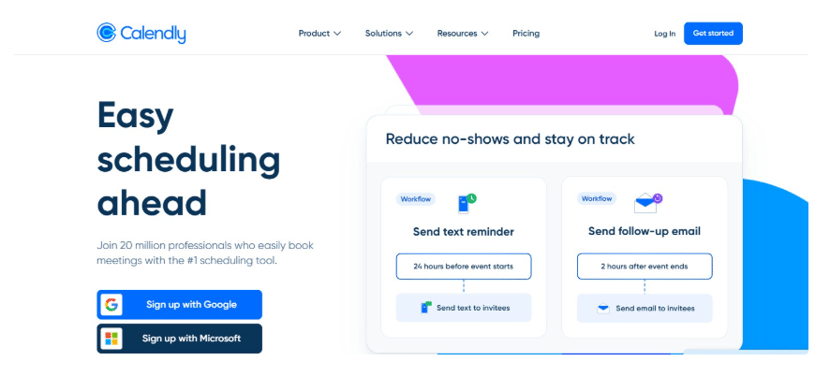
Features
- Easy Scheduling – Share a link so clients and prospects can book time based on your availability.
- Calendar Integration – Syncs with Google, Outlook, Office 365, and iCloud calendars.
- Automated Reminders & Notifications – Sends email and SMS reminders to reduce no-shows.
- Time Zone Detection – Automatically adjusts for client time zones.
- Team Scheduling – Round-robin, collective, or one-on-one meeting options for team members.
- Payment Collection – Integrates with Stripe or PayPal to collect payments during booking.
- Integrations & Automation – Connects with CRM, marketing, and productivity tools via Zapier, Salesforce, HubSpot, and more.
Pros
- Saves time
- User-friendly
- Calendar sync
- Customizable booking pages
- Team scheduling options
- Automated reminders
- Integrations
Cons
- Advanced features require a paid plan
- Limited branding on the free plan
- Scaling complexity for large teams
- No built-in CRM
Pricing
Calendly's pricing is pretty affordable, but it can be expensive for large companies. There is a free trial, and pricing starts at $10 per seat per month and works its way up to $15 k per year for large companies.
Review
According to G2, Calendly had a 4.7-star rating out of 5.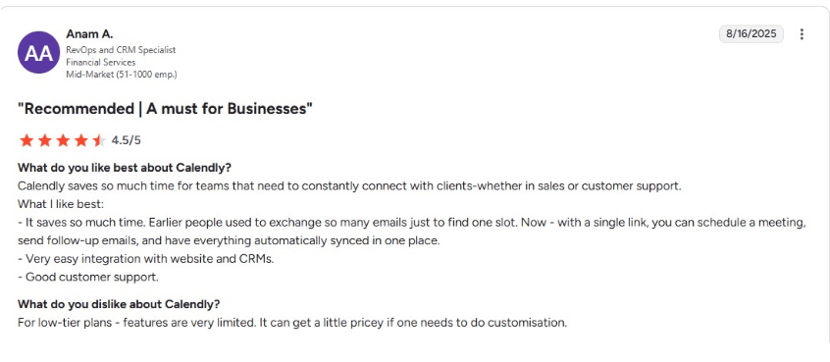
Best CRM sales enablement software
3. Cirrus Insight
Cirrus Insight is a customer relationship management tool that uses AI to help you book more meetings and capture sales activity without manual entry.
The company was founded in 2011 and is a sales enablement platform for Gmail and Outlook. It offers an all-in-one tool to help sales teams reach their goals.
Features
- Salesforce Sync - Automatically syncs emails, calendar events, tasks, etc., with Salesforce (both standard and custom objects)
- Salesforce Sidebar (Inbox Sidebar / Embedded CRM in Email) - Lets you access and update Salesforce records directly from your email client (Gmail or Outlook).
- Smart Scheduler - Route leads to the right person's calendar using customizable workflow logic.
- Email Blast - Sending personalized email outreach at scale (bulk or semi-bulk) using templates.
- Buyer Signals - Track when prospects open your emails, click links, and engage with attachments.
- Meeting AI - Automate customer and prospect research to ensure you're prepared to drive better outcomes.
Pros
- Strong integration with Salesforce
- Email tracking & engagement visibility
- Useful scheduling tools
- “Inbox-centric” usability
Cons
- Some users mention slow support
- Some users also mentioned that there might be a steep learning curve
Pricing
The pricing ranges from $14 per user per month to $49 per user per month.
There is also a custom pricing option, which allows you to select just the features you want.
Review
This is what a G2 user had to say about Cirrus Insights as a sales enablement tool.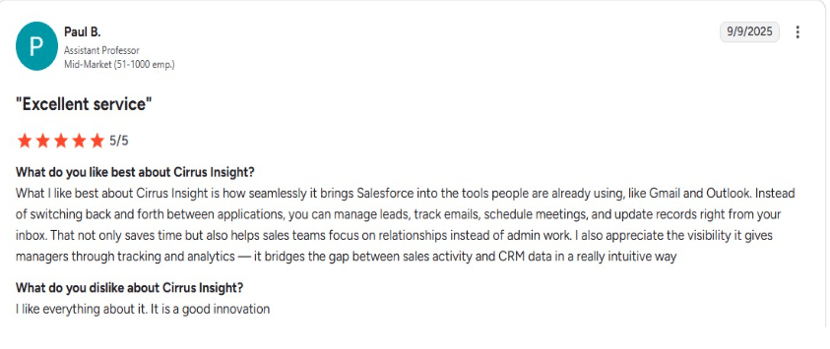
4. Pipedrive
Pipedrive helps keep sales and follow-up activities nice and organized. It's a CRM and pipeline management tool.
Pipedrive is very sales-centric. You can view the data by leads, deals, and upcoming activities. The deal view allows you to see leads that are qualified, whether the conversation started, the meetings booked (there is a hierarchy based on date & time), and leads that got a proposal.
You can also easily drag from one category to the next.
List view is where you can see all the next steps to be taken, and these can be sorted by date or activity. There are also various products to choose from, from sales software to email software, integrations, and Pipedrive AI.
Features
- Pipeline Management – Visual, drag-and-drop pipelines to track deals through stages.
- Contact Management – Stores and organizes leads, people, and organizations in one place.
- Activity & Task Tracking – Schedule calls, meetings, and follow-ups with reminders.
- Email Integration – Two-way email sync, email templates, tracking, and scheduling.
- Sales Automation – Workflow automation for repetitive tasks like assigning leads or sending follow-ups.
- Lead Generation Tools – Web forms, chatbot/live chat, and Prospector tool for finding leads.
- Reporting & Analytics – Customizable dashboards, sales reports, and performance tracking.
- Great database - Add a deal with the lead's name, company, and contact info. If you try to add another lead weeks from now from the same company or with the same email, it'll let you know that that deal/contact/company might already exist.
- Integrations & API – Connects with tools like Slack, Google Workspace, Trello, Zoom, etc.
Pros
- Great design - For a tool with so many features, there is a great balance between keeping things functional without the chaos. There are a lot of options to customize.
- Many integrations - Chatting with leads: Google Meet, MS Teams, Zoom, and many more modern messaging apps like Facebook Messenger and WhatsApp.
- Options to automate tasks - For example, sending email follow-ups every X days.
- Easy to use - Easy drag and drop feature
Cons
- Some users mention occasional tech issues
- You may have to pay more to unlock certain features, especially when it comes to insights/reports
Pricing
Pipedrive pricing is relatively affordable for most small teams. Pricing ranges between $14 per seat per month to $79 per seat per month (all billed annually). Pipedrive also offers a free trial.
Review
This is what a Pipedrive user had to say on G2.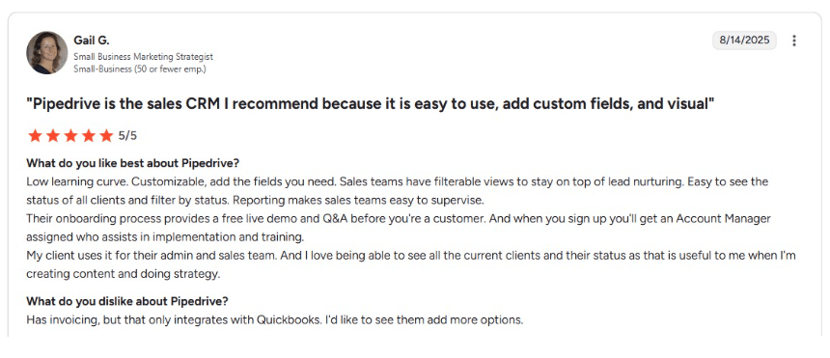
Best content management enablement platforms
5. Loom
Loom is a valuable addition to any sales enablement strategy because it allows sales reps to create quick, personalized video messages.
Instead of relying solely on text-based emails or calls, salespeople can use Loom to explain complex solutions, share product walkthroughs, or provide updates on deals in a way that feels human and engaging.
For sales enablement teams, Loom also works well as a training and onboarding tool. Sales managers can record coaching sessions, product demos, and best practices once, then share them with new hires or the wider revenue teams, saving time while boosting productivity.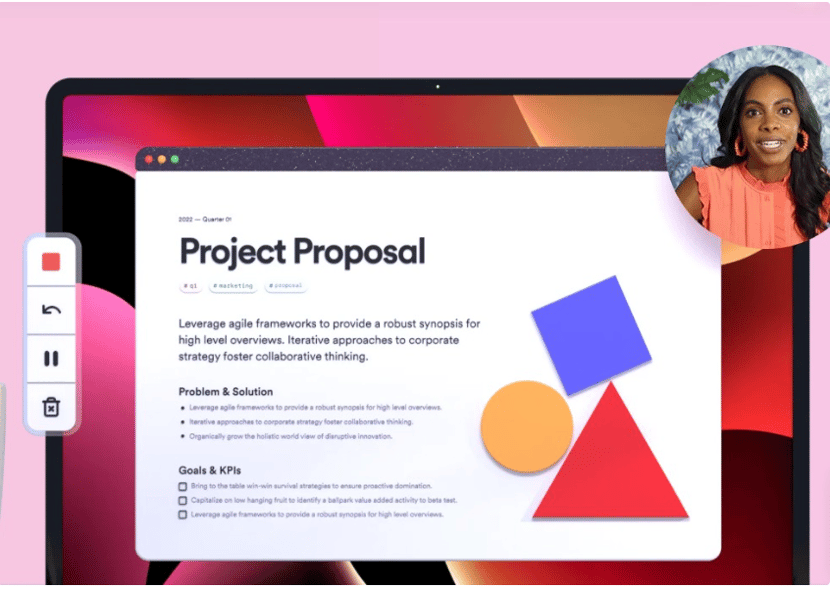
Features
- Screen & Audio Capture – Record your screen and audio on Mac, Windows, or directly through Chrome.
- Mobile Recording – Capture and share recordings from iOS and Android devices with ease.
- Instant Sharing – Distribute videos quickly through a simple shareable link.
- In-App Editing – Trim, cut, and adjust videos directly in the browser or mobile app.
- External Links – Add links inside your video to guide viewers to additional resources.
- Interactive Feedback – Get comments, reactions, and emojis from viewers in real time.
- Annotation Tools – Use drawing features to highlight and emphasize key points.
- Video Embeds – Place videos anywhere—emails, websites, or docs—to maximize visibility.
- Closed Captioning – Provide captions for accessibility and inclusive viewing.
Pros
- Time-Saving – Quickly record and share videos instead of writing long emails or scheduling calls.
- Personalization – Allows sales reps to create tailored messages for prospects and clients.
- Easy Collaboration – Teams can leave comments, reactions, and feedback directly on videos.
- Flexible Sharing – Instant shareable links or embed videos anywhere online.
- Supports Training & Onboarding – Perfect for sharing product demos, tutorials, or coaching sessions.
Cons
- File Size & Storage – Long or high-resolution videos can take up significant space.
- Limited Advanced Editing – In-app editing is basic compared to full video editing software.
- Free Plan Limitations – Some features, like unlimited video length or advanced analytics, require a paid subscription.
Pricing
Loom has a generous free plan with 25 videos and 5-minute screen recordings. Then pricing works its way up from $15 per user per month to $20 per user per month.
Review
According to G2, Loom has a 4.7-star rating out of 5. Below, you can see what a Loom user has to say:
6. Highspot
Highspot is a single, AI-powered enterprise platform that helps organizations plan, implement, and enhance their go-to-market strategies.
It was created to enhance sales productivity by centralizing content, training, and analytics. It helps sales teams, marketing, and revenue operations to collaborate effectively, streamline workflows, and drive revenue growth.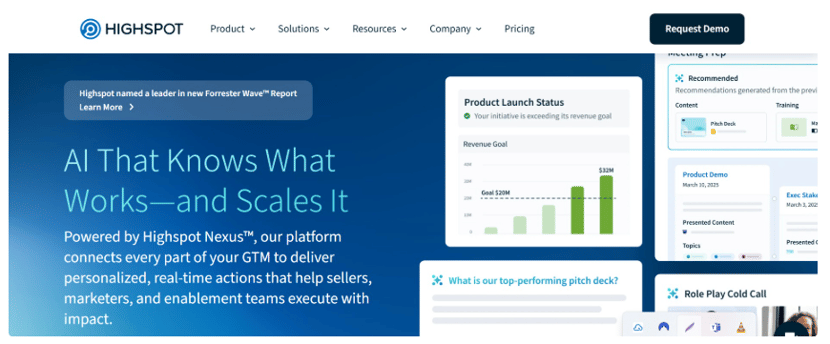
Features
- Unified analytics -Everyone in your team can connect to actionable analytics that enable the connection between enablement efforts to business outcomes.
- Content Management – Centralized hub to store, organize, and update sales and marketing materials.
- AI-Powered Recommendations – Intelligent suggestions on which content or actions will be most effective for a given buyer persona or sales scenario.
- Performance Analytics – Detailed reporting to help sales managers and sales leaders link enablement activities to business outcomes.
Pros
- Comprehensive Enablement Platform
- AI-Driven Insights
- Many Integrations
- Improved Collaboration
- Buyer Engagement Tracking
- Scalable for Enterprises
Cons
- Pricing Transparency – No public pricing, requiring businesses to request a custom quote.
- Cost for Small Teams – The à la carte pricing model can become expensive for startups or smaller sales enablement teams.
- Learning Curve – With so many features, new users may need time and training to fully adopt the platform.
- Over-Reliance on Integrations – Some advanced functionality depends heavily on CRM or DAM integrations.
Pricing
Unfortunately, Highspot doesn't list their pricing on their website. You would have to contact them directly.
Review
Highspot has a 4.7-star rating out of 5 on G2. This is what a Highspot user has to say: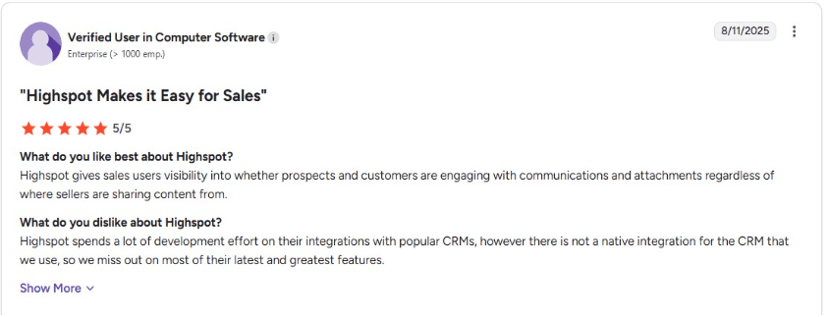
Best tools for onboarding and sales training
7. Mindtickle
Mindtickle is a sales enablement and training platform designed to help revenue teams improve performance through structured training, coaching, and analytics.
Companies use it to onboard new reps faster, reinforce skills, and ensure sales teams stay aligned with messaging and best practices.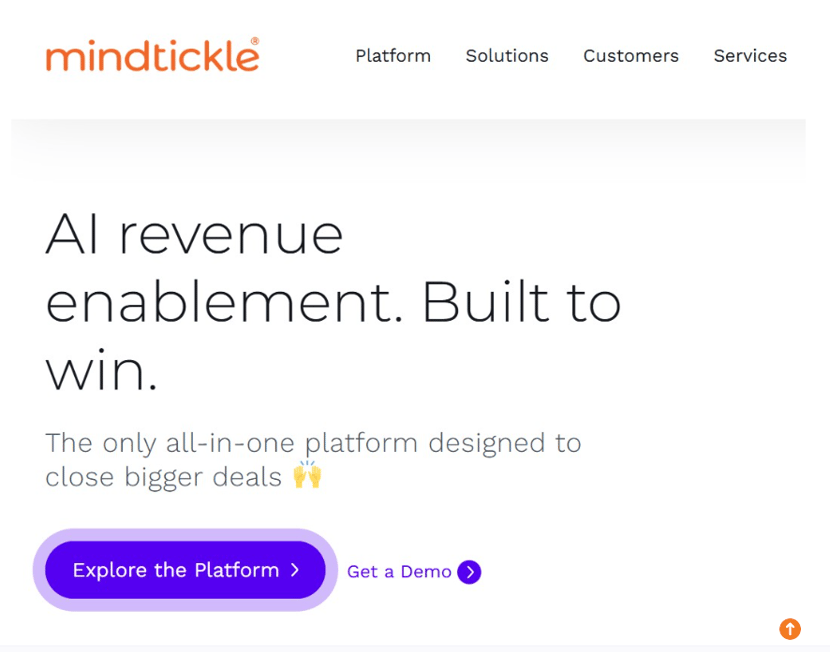
Features
- Sales Readiness & Training – Delivers structured onboarding, microlearning, and skill development programs.
- Coaching Tools – Managers can assess, give feedback, and track rep progress with real-time insights.
- Analytics & Insights – Get visibility into team performance, knowledge gaps, and sales effectiveness with data-driven reports.
- Integrations – Works with major CRMs
- Sales content management - Find, share, and track your content to see what's converting
Pros
- Strong focus on sales training and ongoing skill reinforcement.
- Good analytics that highlight performance gaps and training impact.
- Engaging features like AI role play that keep teams motivated
Cons
- It can be overwhelming for smaller teams because it has a ton of features
- It takes time to set up training libraries
- Pricing can be expensive
Pricing
There are 3 pricing subscriptions according to their own blog, but they don't list their pricing, unfortunately. You would have to book a demo to find out more.
Reviews
According to G2, Mindtickle has a 4.7-star rating out of 5. This is what one user had to say: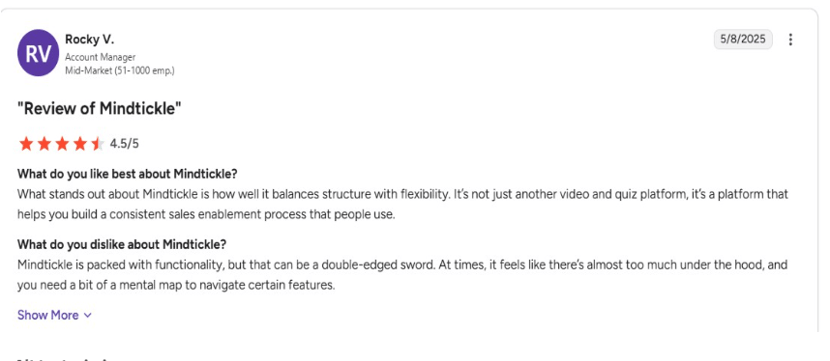
8. Membrain
If you’re in B2B and dealing with long, complicated sales cycles, Membrain might be worth looking at.
Unlike lightweight CRMs, it’s designed to guide reps through each stage of the process with built-in coaching, playbooks, and content.
Membrain helps shape sales behaviors by showing the right content at the right time within the sales process. It lets teams embed training materials, sales resources, and playbooks directly into the workflow, so reps can learn, stay aligned, and apply knowledge in context.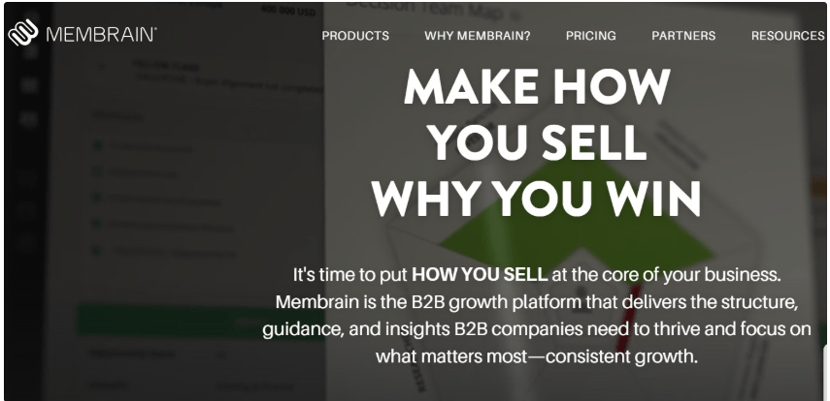
Features
- Playbooks for Prospecting – Step-by-step guides that show reps how to qualify and move deals forward.
- Content Hub – Keeps all your sales content in one place and makes sure the right material shows up when you need it.
- Pipeline Management – Visual tools to track opportunities, forecast, and manage deals.
- Account Planning – Map out key accounts, spot growth opportunities, and collaborate with your team on strategy.
- Coaching Tools – Sales managers can embed best practices into the workflow and coach reps in real time.
- Customizable Processes – Adapt sales stages and steps to fit your company’s sales strategy.
- Analytics & Dashboards – Track what’s working, see where deals get stuck, and measure sales performance.
Pros
- Great for keeping complex B2B sales organized.
- Puts sales playbooks and content right where reps need them.
- Gives sales leaders visibility into the pipeline and rep activity.
- Helps with both new business and growing existing accounts.
Cons
- Setup takes time; you’ll need to define your process, content, and playbooks.
- It can feel like too much if your sales cycle is short and simple.
- Cost can add up for smaller teams.
Pricing
Membrain has a few pricing tiers to suit different needs. You can expect to pay between $49 - $299 per user per month.
Review
According to G2, Membrain has a 4.6-star rating out of 5. This is what one user had to say: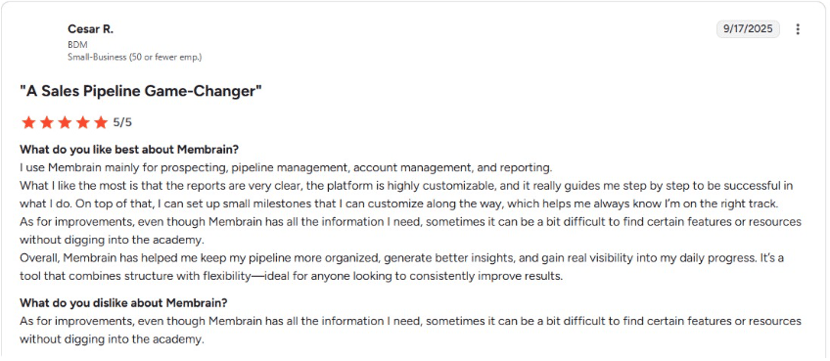
In conclusion
Sales enablement tools aren’t just nice to have; they help your team work smarter, stay on the same page, and close more deals.
Whether it’s scheduling meetings, managing content and coaching, or guiding reps through complex sales cycles, the right tools make a real difference.
Pick the ones that fit your team’s process, keep adoption simple, and watch productivity and results improve.

.png?width=1268&height=1772&name=Sidebar-C%20(1).png)
